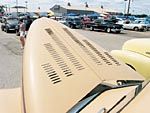
"It ain't a hot rod until it's got a bunch of louvers in it," or so says Editor Brian Brennan. He should know; Hot Rods by Dean recently built him a sharp A-bone on Deuce 'rails, and even though many say it's Brian's finest car, one thing prevented it from being his finest hot rod: louvers. While the car kept cool and technically it looked great without them, it just didn't look right.
The link between louvers and performance, while indirect, is strong. When fan and cooling technology was low, automobile manufacturers cut holes in the engine's compartment to relieve it of the engine's waste heat. Louvers became the preferred hole since they required simple tooling, imparted a sort of visual element, and somewhat protected the engine from damaging elements like water, dust, thieves, and the kid next door.
As engine power grew, so did the waste heat the engine generated and the need to evacuate that much more heat from the engine bay. As a result, louvers became a layman's means to evaluate a car's performance: More louvers must mean more power, right? Just look at a Model J Duesenberg or an Auburn boattail speedster; there's practically more hole than hood on the things, and they're fast bastards.
Hot rodders, specifically those after World War II, immediately picked up on the louver practice, as they often crammed the largest engine capable of generating the most heat-like a V-8 Ford, Olds, or Cadillac-into the smallest cars with the least means to shirk that heat. Eventually, lakes and drag racers, citing the Law of More (more means better), started ventilating more than just engine compartments; trunk lids, roofskins, and every other low-crown sheetmetal surface began to bear the mark of the local louver punch. Before you knew it, the kid with the hand-me-down Plymouth sedan showed up to the burger stand with a split manifold and louvered hood in a bid to win something-even if only the appeal of the opposite sex.
And half a century on, we're still stuck on louvers.
Luckily the louver is easy to implement, even if it's somewhat tough to master. Louver dies aren't much more than a cross between a paper punch and your dad's handheld book embosser in that they simultaneously form and slice sheetmetal. They differ from the handheld units in the fact that they require pressure like that generated by a mechanical punch or hydraulic press to form their shape in metal.
If louvers have a downside, it's availability; not many more companies offer louver dies today as they did in the past. Mittler Bros., Van Sant Enterprises, and Fournier Enterprises all carry Mittler Bros. 1- to 5-inch die sets and hydraulically operated kits; however, many of the noted louver pressers like Stan Betz and Eric Vaughn (who admittedly based his on Art Ingels', of Kurtis Kraft fame, dies), made their own from tool steel and tubing. According to Betz, "There was never all that much demand for louver dies. After all, one guy with some dies could cover an area like Orange County." Williams Lowbuck Tools makes a handy set of dies that transform a bead roller into a louver machine that will form straight or curved louvers in any length, but they depart so radically from the punch style that we will address them in another story.
If you're not into buying or making your own dies, or even punching your own louvers for that matter, consider commissioning Dean Livermore, Eric Vaughn, or a third resource, Sir Michaels, to punch the holes in your project. While Eric and Dean's louvers follow a more traditional louver shape, Sir Michaels offers a vast array of louver styles-probably one of the most comprehensive in the country. Since Dean, the guy who built Brian's car in the first place, owns a louver press of his own, Brian's decision came naturally.
Whether you elect to do it yourself or farm it out, and regardless of what style you prefer, always keep the following in mind: You can build a custom car or a smoothie street rod, but until it's riddled with louvers, it'll never be a hot rod. Just ask Brian Brennan. He'll tell you.